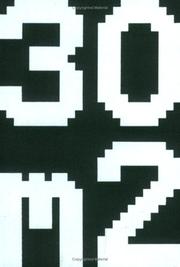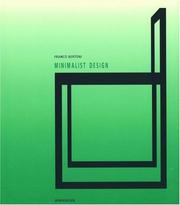| Listing 1 - 9 of 9 |
Sort by
|
Book
ISBN: 9788499366890 Year: 2021 Publisher: Barcelona : Loft Publications,
Abstract | Keywords | Export | Availability | Bookmark
 Loading...
Loading...Choose an application
- Reference Manager
- EndNote
- RefWorks (Direct export to RefWorks)
A visual celebration of minimalist concepts in private spaces, demonstrating the growing popularity of minimalism in architecture and interior design. The growing popularity of minimalism in achitecture and interior design is documented in this impressive survey of the best recent work of the genre created by leading international architects and designers. The New Minimalist Style explains minimalist concepts and concentrates on private spaces. This guide includes hundreds of sophisticated photographs and introductions to each chapter written by leaders of this extraordinary, contemporary architecture & design movement. All the examples featured in the book have one thing in common: they feature the essential, but use the minimal.
Architecture minimale --- minimaliste --- Minimal architecture --- Minimal design.
Book
ISBN: 9781848823716 9781848823709 1848823711 1848823703 Year: 2009 Publisher: London Springer-Verlag London
Abstract | Keywords | Export | Availability | Bookmark
 Loading...
Loading...Choose an application
- Reference Manager
- EndNote
- RefWorks (Direct export to RefWorks)
In this age of complexity, simple, powerful systems are an ideal of interaction design. This book introduces minimalism and helps to make sense of reduction, and in doing so unravels some of the mysteries of simplicity. Minimalism becomes an essential tool to help visualise the simple, and to unveil and instantiate patterns for designing simplicity. Divided into five parts, the first delivers an introduction to the concept of minimalism and overviews the main themes covered in the book; Part two retraces the history of minimalism in art and music illustrating the breadth of concepts underlying works characterized as minimal, and showing the recurrence of these attributes in different disciplines. Four kinds of minimalism for interaction design are defined. The third part connects the concepts developed in the book to current thinking in HCI, examining norms, rules and guidelines. In part four, the simplicity of real designs is examined from a minimal perspective, and tools for different forms of reduction in design are discussed. The final section returns to more theoretical discussions of the notions of minimalism, re-evaluating the product and process threads for the changes brought about for the understanding of minimalism and the relation of aesthetics and minimalism in design. The book concludes with a look at issues and limitations that lie unanswered, and some of their possible resolutions.
informatica --- Computer. Automation --- System Design --- Human-computer interaction --- Minimal design
Book
ISBN: 9781935935384 1935935380 Year: 2016 Publisher: [Novato, California] : ORO Editions,
Abstract | Keywords | Export | Availability | Bookmark
 Loading...
Loading...Choose an application
- Reference Manager
- EndNote
- RefWorks (Direct export to RefWorks)
Austere Gardens suggests that being open to other ways of observing and sensing can yield new insights and rewards, and that interest is found in places unassuming and overlooked as well as those complex and assertive. Perceiving is only one half of the story, however. Realising places using simple acts and reduced means is the other half. The history of garden-making reveals continued attempts to create an Eden, to surpass our given environment in abundance and delight, and by selected instruments transcend the constraints of site, topography, and climate. The alternative to this garden of inclusion lies in the landscapes of reduction and compression, for example the dry gardens of Japan. These might be termed austere gardens. The word austere, as used in this essay, does not imply asceticism, but merely modesty and restraint. Austere landscapes may first appear devoid of interest if noticed at all. To those who do not look beyond their surfaces, these sites, and the world outside them, usually appear plain and uninteresting, or even lacking of the very properties by which we define a garden. But there are sensual, aesthetic, and even philosophical, pleasures to be gained from these seemingly dull fields should we attempt to appreciate them. These qualities, normally associated with abundance and complexity, may be found in a different way, and at a different level, in austere terrain. [Back cover]
Landscape architecture --- Philosophy. --- Gardens --- Landscape architecture. --- Gardens in art. --- Minimal design. --- Architecture du paysage --- Art des jardins --- Design --- History. --- histoire. --- Gardens in art --- Minimal design --- History --- Gardens - Design - History

ISBN: 8493311499 9788493311490 Year: 2006 Publisher: Barcelona Fira de Barcelona
Abstract | Keywords | Export | Availability | Bookmark
 Loading...
Loading...Choose an application
- Reference Manager
- EndNote
- RefWorks (Direct export to RefWorks)
728.2 --- 747.82 --- 728.2/3 --- Appartementsgebouwen --- Appartementen (architectuur) --- Appartementen (interieurarchitectuur) --- Kleine appartementen --- Compacte woningen --- Apartments --- Minimal design. --- Appartements --- Design minimal
Book
ISBN: 1447122844 1848823703 9786612332135 1282332139 1848823711 Year: 2009 Publisher: London : Springer-Verlag,
Abstract | Keywords | Export | Availability | Bookmark
 Loading...
Loading...Choose an application
- Reference Manager
- EndNote
- RefWorks (Direct export to RefWorks)
In this age of complexity, simple, powerful systems are an ideal of interaction design. This book introduces minimalism and helps to make sense of reduction, and in doing so unravels some of the mysteries of simplicity. Minimalism becomes an essential tool to help visualise the simple, and to unveil and instantiate patterns for designing simplicity. Divided into five parts, the first delivers an introduction to the concept of minimalism and overviews the main themes covered in the book; Part two retraces the history of minimalism in art and music illustrating the breadth of concepts underlying works characterized as minimal, and showing the recurrence of these attributes in different disciplines. Four kinds of minimalism for interaction design are defined. The third part connects the concepts developed in the book to current thinking in HCI, examining norms, rules and guidelines. In part four, the simplicity of real designs is examined from a minimal perspective, and tools for different forms of reduction in design are discussed. The final section returns to more theoretical discussions of the notions of minimalism, re-evaluating the product and process threads for the changes brought about for the understanding of minimalism and the relation of aesthetics and minimalism in design. The book concludes with a look at issues and limitations that lie unanswered, and some of their possible resolutions.
Human-computer interaction. --- Minimal design. --- System design. --- System design --- Human-computer interaction --- Minimal design --- Computer Science --- Engineering & Applied Sciences --- Human engineering. --- Ergonomics --- Human factors in engineering design --- Computer-human interaction --- Human factors in computing systems --- Interaction, Human-computer --- Computer science. --- User interfaces (Computer systems). --- Computer Science. --- User Interfaces and Human Computer Interaction. --- Interfaces, User (Computer systems) --- Human-machine systems --- Informatics --- Science --- Bioengineering --- Environmental engineering --- Industrial engineering --- Human comfort --- Human-robot interaction --- Human engineering --- User-centered system design --- User interfaces (Computer systems)
Book
ISBN: 0500292191 9780500292198 Year: 2016 Publisher: Thames & Hudson
Abstract | Keywords | Export | Availability | Bookmark
 Loading...
Loading...Choose an application
- Reference Manager
- EndNote
- RefWorks (Direct export to RefWorks)
Graphic arts --- Minimal design --- Minimal art --- 655.26 --- grafische vormgeving --- minimalisme --- Art, Minimal --- Minimalism (Art) --- Minimalist art --- Systematic painting --- Art, Abstract --- Art, Modern --- Minimalism (Design) --- Minimalist design --- Design --- Art, Graphic --- Arts, Graphic --- Graphic design (Graphic arts) --- Graphics --- Art --- Visual communication --- grafische vormgeving, typografie --- Grafische vormgeving
Book
ISBN: 9780856677038 0856677035 Year: 2010 Publisher: London : New York : Philip Wilson Publishers ; Distributed in North America by Palgrave Macmillan,
Abstract | Keywords | Export | Availability | Bookmark
 Loading...
Loading...Choose an application
- Reference Manager
- EndNote
- RefWorks (Direct export to RefWorks)
modernisme --- toegepaste kunsten --- interieurs --- minimalisme --- design --- meubilair --- Frank, Jean-Michel --- Errázuriz, Eugenia --- Pirovano, Ignacio --- 1915 - 1945 --- 20ste eeuw --- Interior decoration --- History --- Minimal design --- Frank, Jean-Michel, --- Errazuriz, Eugenia --- modernisme. --- interieurs. --- minimalisme. --- design. --- meubilair. --- Frank, Jean-Michel. --- Errázuriz, Eugenia. --- Pirovano, Ignacio. --- 1915 - 1945. --- 20ste eeuw.

ISBN: 3764365064 Year: 2004 Publisher: Basel Birkhäuser
Abstract | Keywords | Export | Availability | Bookmark
 Loading...
Loading...Choose an application
- Reference Manager
- EndNote
- RefWorks (Direct export to RefWorks)
Franco Bertoni --- lunst --- meubelkunst --- design --- productdesign --- verlichting --- meubels --- meubilair --- minimalisme --- twintigste eeuw --- Judd Donald --- Wilson Robert --- Rams Dieter --- Munari Bruno --- Fronzoni AG --- Mari Enzo --- Ando Tadao --- Astori Antonia --- Silvestrin Claudio --- Pawson John --- Gabellini Michael --- Souto de Moura Edouardo --- Nouvel Jean --- Brandolini Andreas --- Authentics --- Wettstein Hannes --- Grcic Konstantin --- Morrison Jasper --- Van Severen Maarten --- Hutten Richard --- Lissoni Piero --- Van Duysen Vincent --- 749.036 --- 745.036 --- 745 --- CAD, design en industriële vormgeving --- Design --- Minimal design --- Minimalism (Design) --- Minimalist design --- Creation (Literary, artistic, etc.) --- History
Book
ISBN: 9781635572100 9781635572117 163557210X Year: 2020 Publisher: New York, N.Y. Bloomsbury Publishing
Abstract | Keywords | Export | Availability | Bookmark
 Loading...
Loading...Choose an application
- Reference Manager
- EndNote
- RefWorks (Direct export to RefWorks)
"Kyle Chayka is one of our sharpest cultural observers. After spending years covering minimalist trends for leading publications, he now delves beneath this lifestyle's glossy surface, seeking better ways to claim the time and space we crave. He shows that our longing for less goes back further than we realize. His search leads him to the philosophical and spiritual origins of minimalism, and to the stories of artists such as Agnes Martin and Donald Judd; composers such as John Cage and Julius Eastman; architects and designers; visionaries and misfits. As Chayka looks anew at their extraordinary lives and explores the places where they worked--from Manhattan lofts to the Texas high desert and the back alleys of Kyoto--he reminds us that what we most require is presence, not absence. The result is an elegant new synthesis of our minimalist desires and our profound emotional needs"--
Philosophy and psychology of culture --- General ethics --- Simplicity --- Minimal design --- Minimal art --- Minimal architecture --- Voluntary simplicity movement --- Back-to-simplicity movement --- Simplicity movement --- VS movement --- Social movements --- Minimalism (Architecture) --- Minimalism in architecture --- Minimalist architecture --- Architecture --- Art, Minimal --- Minimalism (Art) --- Minimalist art --- Systematic painting --- Art, Abstract --- Art, Modern --- Minimalism (Design) --- Minimalist design --- Design --- Conduct of life --- 72.039 --- 72.039 Hedendaagse architectuur. Bouwkunst sinds 1960 --- Hedendaagse architectuur. Bouwkunst sinds 1960
| Listing 1 - 9 of 9 |
Sort by
|

 Search
Search Feedback
Feedback About UniCat
About UniCat  Help
Help News
News